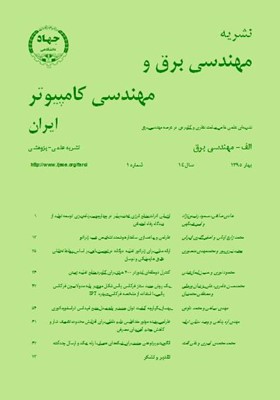طراحی و پیادهسازی ساختار هوشمند تشخیص عیب ژنراتور
محورهای موضوعی : مهندسی برق و کامپیوترمحمد زارع ارنانی 1 * , اصغر اکبری 2
1 - جهاد دانشگاهی صنعتی خواجه نصیرالدین طوسی
2 - دانشگاه صنعتی خواجه نصیرالدین طوسی
کلید واژه: تحلیل سلسلهمراتبی تشخیص عیب ژنراتور,
چکیده مقاله :
وقوع خطا و خروج ناگهانی ژنراتورها از مدار میتواند خسارات مالی سختی در پی داشته باشد، بدین سبب روشهای مختلف ارزیابی وضعیت ژنراتورها گسترش یافتهاند. قصد این مقاله گردآوری اطلاعات مهم ژنراتور و انجام یک تحلیل جامع توسط روش تحلیل سلسلهمراتبی است. فرایند تحلیل سلسلهمراتبی یک روش تحلیل چندمعیاری است که برای ترکیب نتایج روشهای تشخیصی به هنگام و تشخیص محتملترین عیب و قسمت معیوب ژنراتور به کار رفته است. در این راستا چندین جدول مقایسهای تشکیل شده و نهایتاً این روند منجر به آشکارسازی محتملترین عیب ژنراتور در حال کار خواهد شد. در این مقاله چگونگی طراحی و پیادهسازی ساختار تشخیص عیب LEMS به همراه نتایج شبیهسازی دو ساختار نمونهای مورد بحث قرار گرفته است.
Generators failure and generators break down can cause high financial consequences. For this reason, several concepts for the condition monitoring of generators have been developed. The purpose of this article is to collect significant generator data in order to form a comprehensive analysis by analytical hierarchy process (AHP) method. The AHP is a multi-criteria analysis approach, where is used in order to combine the results of online diagnostic methods and draw conclusions on the most probable failure. A fault diagnosis structure has been designed and several comparison charts have been generated. This trend led to the running generator probable failure, to be revealed. In this paper the circumstances of design and implementation of the LEMS structure with two simulation results are described.
[1] C. Sumereder, C. Rupp, M. Muhr, H. Egger, and M. Marketz, "Condition evaluation of hydro generators," in Proc. 8th Int. Conf. Properties and Applications of Dielectric Materials, pp. 285-288, Jun. 2006.
[2] P. K. Dey, "Decision support system for inspection and maintenance: a case study of oil pipelines," IEEE Trans. on Engineering Management, vol. 51, no. 1, pp. 47-56, Feb. 2004.
[3] W. Xiao-Bin, C. Wen-Yu, S. Shi-Xin, and L. Jing-Bo, "A method of remote fault diagnosis based on analytical hierarchy process," in Proc. IEEE Conf. Robotics, Automation and Mechatronics, pp. 693-696, 21-24 Sep. 2008.
[4] S. Bin and C. Mingbang, "Power transformer Dga integrated diagnosis system based on oracle database," in Proc. Asia-Pacific Power and Energy Engineering Conf., APPEEC'09, 4 pp., Mar. 2009.
[5] W. You-Yuan, et al., "Study of an assessment method for the reliability of tap-changers in power transformer based on fault-tree analysis," in Proc. Int. Conf. High Voltage Engineering and Application, ICHVE'08, pp. 604-608, 9-12 Nov. 2008.
[6] P. C. Lin, J. C. Gu, and M. T. Yang, "Intelligent maintenance model for condition assessment of circuit breakers using fuzzy set theory and evidential reasoning," IET Generation, Transmission & Distribution, vol. 8, no. 7, pp. 1244-1253, Jul. 2014.
[7] H. Meyar-Naimi and S. Vaez-Zadeh, "Sustainability assessment of a power generation system using DSR-HNS framework," IEEE Trans. on Energy Conversion, vol. 28, no. 2, pp. 327-334, Jun. 2013.
[8] S. V. Daneshmand, H. Heydari, and S. Shakeri, "Multicriteria optimal winding scheme in HTS transformers by analytical hierarchy Process," IEEE Trans. on Applied Superconductivity, vol. 21, no. 1, pp. 2-12, Feb. 2011.
[9] L. Wang and L. Pan, "A method of evaluating online operating state of transformer," in Proc. China Int. Electricity Distribution Conf., CICED'14, pp. 1014-1017, 23-26 Sep. 2014.
[10] T. L. Saaty, Fundamentals of Decision Making and Priority Theory with the Analytic Hierarchy Process, vol. VI, Pittsburgh: RWS Publications, 1994.
[11] T. L. Saaty, The Analytical Hierarchy Process, New York: McGraw-Hill, 1980.
[12] M. Zare and A. Akbari, "A method based on analytical hierarchy process for generator risk assessment," in Proc. of the 2010 Int. Conf. on Condition Monitoring and Diagnosis, pp. 1130-1133, Tokyo, Japan, Sep. 2010.
[13] C. Hudon and M. Belec, "Partial discharge signal interpretation for generator diagnostics," IEEE Trans. on Dielectrics and Electrical Insulation, vol. 12, no. 2, pp. 297-319, Apr. 2005.
[14] D. L. Evans, "IEEE working group report of problems with hydrogenerator thermoset stator windings," IEEE Trans. on Power Apparatus and Systems, vol. 100, no. 7, pp. 3284-3291, Jul. 1981.
[15] R. Brutsch, M. Tari, K. Frohlich, T. Weiers, and R. Vogelsang, "Insulation failure mechanisms of power generators," IEEE Electrical Insulation Magazine, vol. 24, no. 4, pp. 17-25, Jul./Aug. 2008.
[16] S. Li and J. M. Y. Chow, "Partial discharge measurements on hydro generator stator windings case studies," Electrical Insulation Magazine, IEEE, vol. 23, no. 3, pp. 5-15, May/Jun. 2007.
[17] C. Sumereder, "Statistical lifetime of hydro generators and failure analysis," IEEE Trans. on Dielectrics and Electrical Insulation, vol. 15, no. 3, pp. 678-685, Jun. 2008.
[18] G. C. Stone, C. V. Maughan, D. Nelson, and R. P. Schultz, "Impact of slot discharges and vibration sparking on stator winding life in large generators," IEEE Electrical Insulation Magazine, vol. 24, no. 5, pp. 14-21, Sep./Oct. 2008.
[19] G. C. Stone, E. A. Boulter, I. Culbert, and H. Dhirani, Electrical Insulation for Rotating Machines Design, Evaluation, Aging, Testing, and Repair, New York: John Wiley, 2004.

